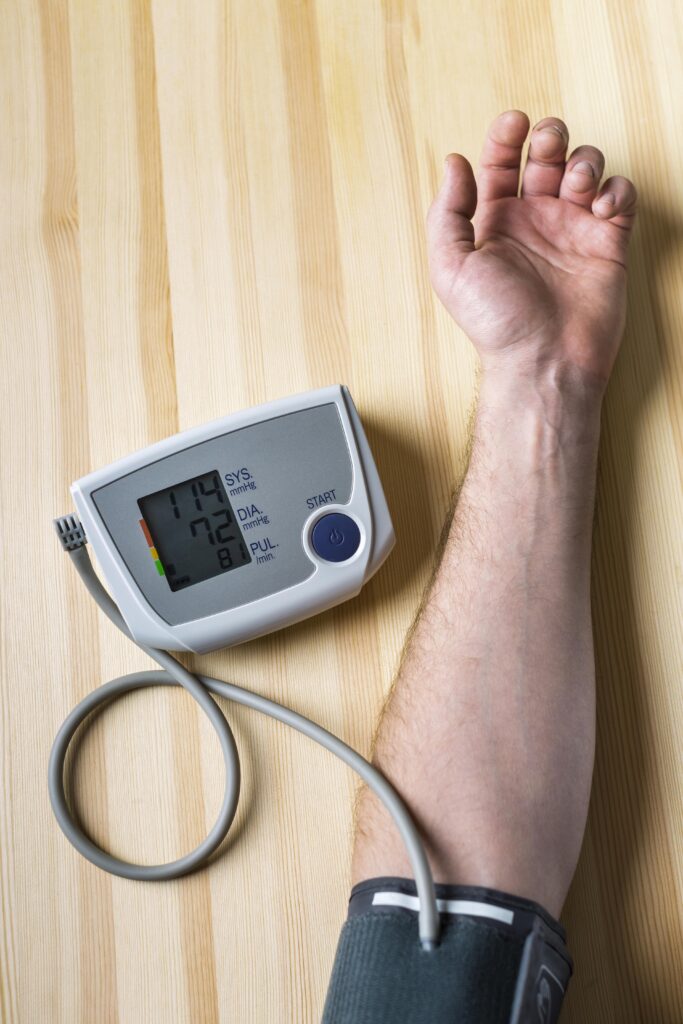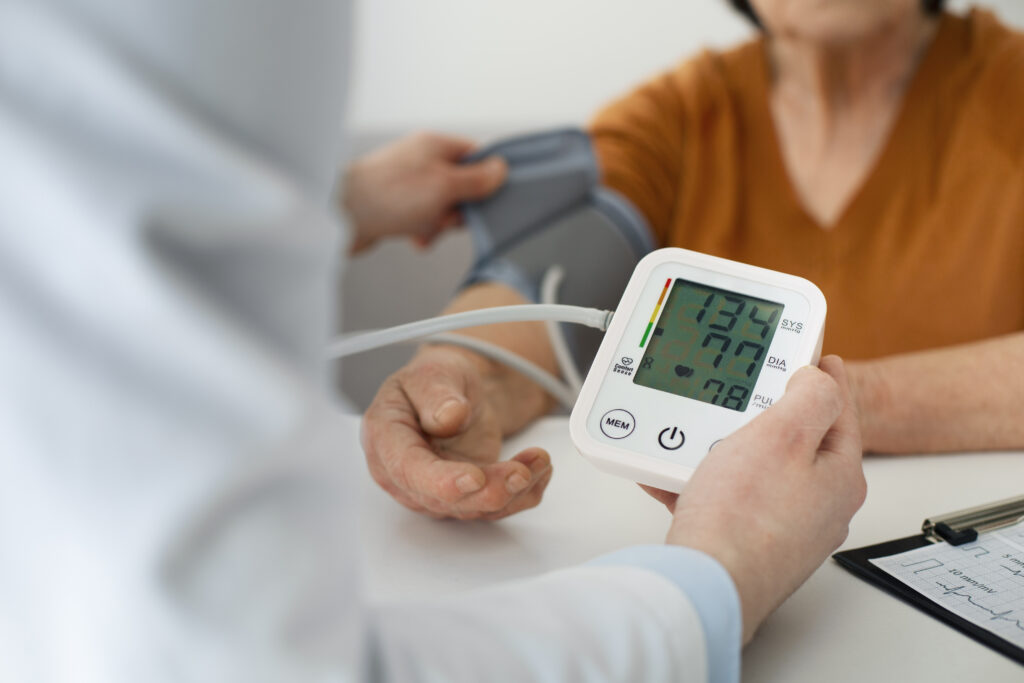“High blood pressure, or hypertension, affects millions worldwide. Understand its causes, symptoms, and treatment options to take control of your heart health.”

Table of Contents
What Is High Blood Pressure?
Also known as hypertension occurs when force of blood is consistently high over your arterial wall. Over time, this pressure can cause serious health problems such as heart disease, stroke, and kidney damage
Understanding Blood Pressure Numbers
Blood pressure readings are shown as two numbers:
Systolic (top number): pressure during heartbeats
Diastolic (bottom number): pressure between beats
Blood Pressure Chart for Adults:
| Category | Systolic (mmHg) | Diastolic (mmHg) |
|---|---|---|
| Normal | Less than 120 | Less than 80 |
| Elevated | 120–129 | Less than 80 |
| High BP Stage 1 | 130–139 | 80–89 |
| High BP Stage 2 | 140 or higher | 90 or higher |
| Hypertensive Crisis | Over 180 | Over 120 |
What Causes High Blood Pressure?
It can be primary or secondary.
Primary Hypertension
Develops gradually over years and has no identifiable cause.
Secondary Hypertension
Linked to specific health conditions, including:
- Kidney disease
- Thyroid problems
- Sleep apnea
- Certain medications (e.g., birth control pills, NSAIDs)
- Adrenal gland tumors
- Congenital blood vessel defects
Risk Factors for High Blood Pressure

You’re at greater risk if you:
- Are over 40 years old
- Have a family history of hypertension
- Are overweight or obese
- Eat too much salt or processed food
- Don’t exercise regularly
- Smoke or consume excessive alcohol
- Have chronic stress
- Live with conditions like diabetes or high cholesterol
Common Symptoms of High Blood Pressure
Hypertension is often called “the silent killer” because it usually has no symptoms. However, in some cases, people may experience. High blood pressure symptoms are
- Headaches
- Dizziness
- Blurred vision
- Chest pain
- Shortness of breath
- Nosebleeds
Note: These symptoms often appear only when blood pressure reaches dangerous levels.
How Is High Blood Pressure Diagnosed?
It’s diagnosed using a blood pressure machine (sphygmomanometer). A reading consistently above 130/80 mmHg over multiple checks indicates high blood pressure.

Doctors may also order:
- Blood tests
- Urinalysis
- ECG or echocardiogram
- Ambulatory 24-hour BP monitoring
Why High Blood Pressure Is Dangerous
If left untreated, It can lead to:
- Heart attack or heart failure
- Stroke
- Kidney damage or failure
- Vision loss
- Cognitive decline and dementia
- Aneurysms
How to Treat High Blood Pressure
- Lifestyle Modification

- Eat a heart-healthy diet (e.g., DASH diet)
- Exercise 30 minutes/day, 5 days/week
- Lose excess weight
- Limit alcohol and quit smoking
- Reduce salt intake (less than 1,500 mg/day)
- Manage stress through relaxation techniques
- Medications for High Blood Pressure
Common types include:
- ACE inhibitors
- Beta-blockers
- Calcium channel blockers
- Diuretics
- ARBs (angiotensin II receptor blockers)
Treatment is often long-term and adjusted based on how your body responds.
Monitoring Your Blood Pressure at Home
Home monitoring is vital. Use a digital blood pressure machine:
Sit calmly for 5 minutes before measuring
Rest arm at heart level
Take readings at the same time daily
Keep a record to show your doctor
Hypertensive Urgency vs. Hypertensive Emergency: Key Differences and Management
Hypertensive crises are acute, severe elevations in blood pressure that require prompt clinical attention. They are broadly classified into two categories: hypertensive urgency and hypertensive emergency. Distinguishing between the two is critical, as their management strategies differ significantly.
✅ What Is Hypertensive Urgency?
Definition:
A hypertensive urgency is defined as a severe elevation in blood pressure (usually ≥180/110 mmHg) without evidence of acute target organ damage.
Clinical Presentation:
- Asymptomatic or mild symptoms (e.g., headache, anxiety, epistaxis)
- No signs of encephalopathy, chest pain, or renal impairment
Examples of cases:
- Poor medication adherence in chronic hypertensives
- Stress-induced elevation without end-organ impact
Management:
- Do not lower BP rapidly. Aim for gradual reduction over 24–48 hours.
- Preferred route: oral antihypertensives
- Captopril
- Clonidine
- Labetalol
- Amlodipine
- Close outpatient follow-up within 48–72 hours
- Reinforce lifestyle modifications and medication compliance
🚨 What Is Hypertensive Emergency?
Definition:
A hypertensive emergency is characterized by severe hypertension (typically ≥180/120 mmHg) with acute target organ damage.
Target organs affected may include:
- Brain: hypertensive encephalopathy, stroke, intracerebral hemorrhage
- Heart: acute left ventricular failure, myocardial infarction, aortic dissection
- Kidneys: acute renal failure
- Eyes: papilledema, retinal hemorrhages
Clinical Presentation:

- Altered mental status, seizures (encephalopathy)
- Chest pain, dyspnea (ACS, heart failure)
- Acute visual changes (retinopathy)
- Oliguria or hematuria (renal involvement)
Management:
- Immediate BP reduction is crucial – but controlled and targeted
- Admit to ICU
- Parenteral antihypertensives (IV)
- Labetalol – for stroke and general use
- Nicardipine – preferred in neurologic cases
- Sodium Nitroprusside – for aortic dissection (with beta-blocker)
- Esmolol – short-acting beta-blocker
- Hydralazine – used in pregnancy-related emergencies
BP reduction goals:
- Lower MAP by 20–25% in the first hour
- If stable, reduce to 160/100 mmHg over the next 2–6 hours
- Avoid rapid drops which can compromise perfusion
🩺 Key Points for Clinical Practice
- Always assess for signs of end-organ damage before deciding on treatment speed and route.
- Don’t rely on BP numbers alone—context is everything.
- Patient education is vital to prevent recurrence, especially post-discharge.
✍️ Closing Note for Medicos
Understanding the nuanced approach to hypertensive crises can prevent catastrophic outcomes. In hypertensive urgency, slow and steady wins. In emergencies, swift but controlled intervention is lifesaving. Equip your decisions with clinical judgment, not just numbers.
When to See a Doctor
You should consult a healthcare professional if:
- Your BP consistently reads 130/80 mmHg or higher
- You may experience symptoms like headaches, dizziness, or chest pain
- You have other chronic conditions (e.g., diabetes or heart disease)
Can High Blood Pressure Be Prevented?
Yes. Start with simple steps
- Eat balanced meals with low sodium
- Stay active
- Limit stress
- Avoid smoking and limit alcohol
- Check your BP regularly
Conclusion
High blood pressure is a common yet serious condition that can silently damage your body over time. The good news? It’s manageable — and often preventable — with the right lifestyle changes and medical care.
Stay informed, check your readings regularly, and talk to your doctor if anything seems off. Your heart will thank you. ❤️


